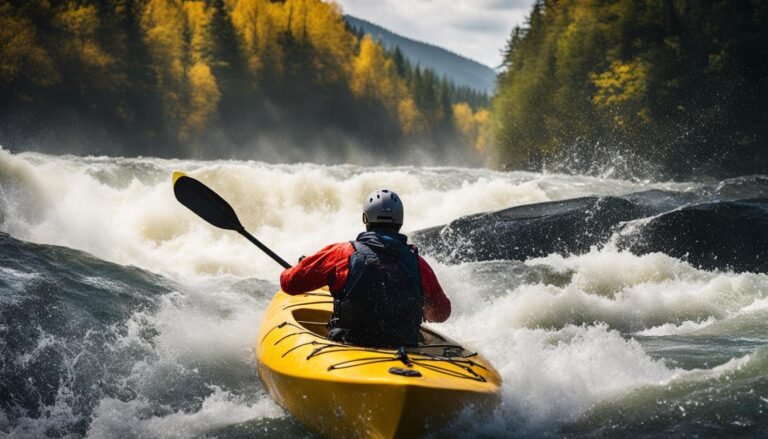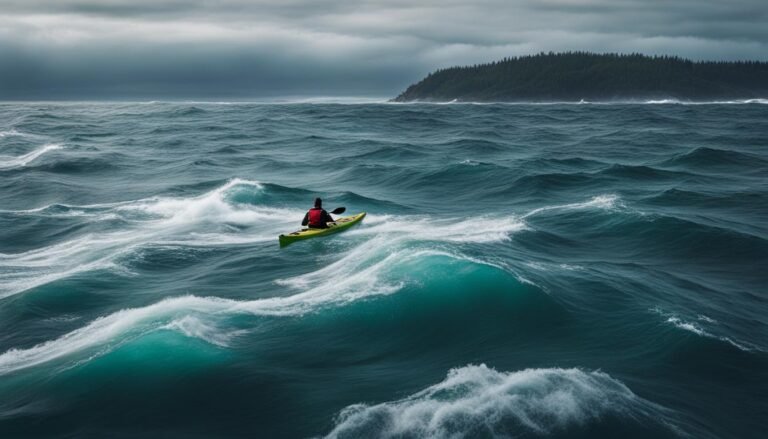Kayaking in 20 MPH Wind Safely: Braving the Currents
When it comes to kayaking, the thrill of navigating the open water is undeniable. But what happens when the wind picks up and the waves start crashing? Kayaking in high winds can be a challenge, but with the right skills and knowledge, you can safely brave the currents and enjoy the adrenaline rush that comes with it.
In this article, we will explore the essentials of kayaking in strong winds and provide you with the tips and techniques you need to know. From understanding the Sea Conditions Rating System (SCRS) to navigating with a compass and chart, we’ve got you covered.
So, if you’re ready to take on the elements and experience the exhilaration of kayaking in 20 mph wind, keep reading!
Key Takeaways:
- Assess the danger and difficulty of the sea conditions using the Sea Conditions Rating System (SCRS).
- Understand the Beaufort Wind Scale and its limitations for kayakers.
- Use a compass and chart for navigation in windy conditions.
- Consider factors such as water temperature, wind speed, wave height, and other hazards.
- Wear appropriate gear and dress for the conditions.
Kayaking Techniques for Windy Weather: Mastering the Elements
Kayaking in windy conditions can be an exhilarating adventure, but it requires proper techniques and skills to navigate safely. Whether you’re a beginner or an experienced kayaker, here are some tips to help you master the elements and enjoy your time on the water:
1. Maintain a low profile
When kayaking in windy weather, it’s important to reduce your profile to minimize the effects of the wind. Keep your body low and close to the kayak, hugging the cockpit with your knees. This lowers your center of gravity and provides better stability, allowing you to maintain control even in gusty conditions.
2. Use a forward stroke technique
When paddling in strong winds, it’s crucial to use the proper stroke technique to maximize efficiency. The forward stroke is the most effective in windy conditions, as it allows you to maintain a steady momentum and counteract the force of the wind. Focus on keeping your strokes long and smooth, engaging your core muscles for added power.
3. Utilize bracing techniques
Bracing is a technique that helps kayakers maintain balance and prevent capsizing in windy conditions. Practice different bracing techniques, such as the low brace and high brace, to stabilize your kayak when the wind tries to tip you over. These techniques involve using your paddle to support your body weight and maintain stability.
“In windy conditions, it’s crucial to stay focused, keep a firm grip on your paddle, and be prepared to react quickly to changing gusts.” – Experienced Kayaker
| Wind Speed | Sea Condition | Safety Precautions |
|---|---|---|
| 0-10 mph | Calm | No specific precautions required, suitable for all skill levels |
| 10-20 mph | Moderate | Exercise caution, be prepared for gusts, maintain a low profile |
| 20+ mph | High | Advanced skills required, use bracing techniques, consider safety equipment like a spray skirt |
Remember, safety should always be your top priority when kayaking in windy weather. Check the weather forecast and sea conditions before heading out, and be sure to dress appropriately with a wetsuit or drysuit. By mastering these techniques and staying aware of your surroundings, you can confidently tackle windy conditions and enjoy the thrill of kayaking in nature’s playground.
Navigating in Windy Conditions: Using a Compass and Chart
When kayaking in windy conditions, it is crucial to have the right tools and techniques for navigation. One of the most essential tools for kayakers is a compass. A marine compass mounted on your kayak allows you to easily read your heading while paddling. To ensure accuracy, align the compass with your kayak’s keel, making sure your heading corresponds with what the compass reads. This will help you maintain your direction and stay on course even in strong winds.
In addition to a compass, using a chart can greatly enhance your navigation skills in windy conditions. Before setting out, take the time to plot your course on a nautical chart. This will help you track your progress and estimate your paddling speed. By keeping track of your heading and speed, you can make adjustments if needed and ensure you are staying on track. Remember to also check for any potential hazards or navigational aids marked on the chart to help you navigate safely.
Using a compass and chart together provides you with a comprehensive navigation system to handle windy conditions. The compass gives you real-time feedback on your heading, while the chart provides you with a visual representation of your course and any potential obstacles. This combination of tools allows you to make informed decisions and stay on course while kayaking in 20 mph wind or other challenging windy conditions.
Best Practices for Navigating in Windy Conditions
- Ensure your compass is mounted securely and is easily visible.
- Take time to familiarize yourself with the symbols and information on a nautical chart.
- Regularly check your compass heading and make adjustments as needed.
- Monitor your progress on the chart and adjust your paddling speed or heading if necessary.
- Stay alert for any potential hazards or changes in conditions.
By following these best practices and using a compass and chart, you can confidently navigate in windy conditions and enjoy your kayaking adventure to the fullest!
| Compass Navigation Tips | Chart Navigation Tips |
|---|---|
| Ensure your compass is mounted securely and is easily visible. | Take time to familiarize yourself with the symbols and information on a nautical chart. |
| Regularly check your compass heading and make adjustments as needed. | Monitor your progress on the chart and adjust your paddling speed or heading if necessary. |
| Use the compass to maintain your direction and stay on course. | Look for potential hazards or navigational aids marked on the chart. |
Remember, practice makes perfect when it comes to navigating in windy conditions. With time and experience, you will become more confident in using a compass and chart to navigate safely and effectively.
Safety Tips and Expert Advice for Kayaking in Windy Weather
When it comes to kayaking in windy conditions, safety should be your top priority. By following these tips and expert advice, you can ensure a safe and enjoyable experience on the water.
Be Mindful of Water Temperature
Before you head out kayaking in windy weather, consider the water temperature. Cold water can be dangerous, so it’s essential to dress appropriately. Wearing a wetsuit or drysuit can help protect you from the cold and prevent hypothermia. Remember to always check the water temperature before embarking on your kayaking adventure and dress accordingly.
Assess Wind Speed and Wave Height
Understanding the wind speed and wave height is crucial when kayaking in windy conditions. The Sea Conditions Rating System (SCRS) can help you assess the difficulty and danger of the conditions. By considering factors such as wind speed, wave height, and other hazards, you can determine if the conditions are suitable for your skill level. Stay informed and avoid kayaking in conditions that may be too challenging or dangerous for you.
Prepare for Hazards
When kayaking in windy weather, it’s essential to be mindful of other hazards that may arise. Breaking waves, rock gardens, sea caves, night conditions, fog, and miscellaneous dangers can all pose risks to kayakers. Familiarize yourself with the area you’ll be kayaking in and be prepared to navigate these hazards safely. Always carry necessary safety equipment, such as a life jacket and a whistle, and stay alert while on the water.
| Key Safety Tips for Kayaking in Windy Weather |
|---|
| Check the water temperature and dress appropriately to prevent hypothermia. |
| Use the Sea Conditions Rating System (SCRS) to assess wind speed, wave height, and other hazards. |
| Be aware of hazards such as breaking waves, rock gardens, sea caves, night conditions, fog, and miscellaneous dangers. |
| Carry necessary safety equipment and stay alert while on the water. |
By taking these safety tips into consideration and following expert advice, you can confidently navigate windy conditions while staying safe. Remember to always prioritize your safety and be prepared for the challenges that may come with kayaking in windy weather.
Conclusion
Kayaking in strong winds can be a thrilling adventure, but it’s essential to have the right gear to ensure your safety and enjoyment. Here are some gear recommendations for kayaking in strong winds:
1. Paddle: Opt for a paddle with a shorter length and larger blade surface area. This will provide you with better control and power to maneuver through the wind and waves.
2. Spray Skirt: A good quality spray skirt will keep water out of your cockpit, preventing it from filling up during windy conditions. Look for a skirt that fits securely and is made from durable, waterproof material.
3. Personal Flotation Device (PFD): Always wear a proper PFD when kayaking, especially in windy conditions. Make sure it fits well and provides enough buoyancy to keep you afloat.
4. Safety Equipment: Carry essential safety equipment such as a whistle, signaling devices, and a first aid kit. These items can be crucial in case of an emergency or unexpected circumstances.
Remember, it’s important to assess the sea conditions using the Sea Conditions Rating System (SCRS) and choose suitable gear accordingly. With the right equipment, you can confidently navigate through strong winds and enjoy the exhilaration of kayaking in challenging conditions.
FAQ
What factors does the Sea Conditions Rating System (SCRS) take into account?
The SCRS considers factors such as water temperature, wind speed, wave height, swim distance to safety, breaking waves, rock gardens, sea caves, night conditions, fog, and other miscellaneous dangers.
Can I use the Beaufort Wind Scale to assess wind conditions for kayaking?
While the Beaufort Wind Scale is useful for sailors, it does not account for the specific challenges faced by kayakers in windy conditions. Kayakers should use the SCRS, which provides a more comprehensive assessment.
How can I navigate in windy conditions?
Using a compass and chart can help you maintain your heading and stay on course. Mount a marine compass on your kayak for easy reading, and align it with the kayak’s keel. Additionally, plotting a course on a chart before setting out can help you estimate your paddling speed and stay on track.
What should I consider for safety in windy conditions?
It’s important to be aware of the water temperature and dress appropriately with wetsuits or drysuits. The SCRS takes into account wind speed and wave height, which are crucial factors in windy conditions. Other hazards such as breaking waves, rock gardens, sea caves, night conditions, fog, and miscellaneous dangers should also be considered.
How can I kayak safely in 20 mph wind?
Understanding wind rating systems and using proper navigation tools, such as a marine compass and chart, can help you safely navigate in windy conditions. By assessing the sea conditions using the SCRS and being prepared with the right gear, you can embrace the thrill of kayaking in 20 mph wind while ensuring your safety.







